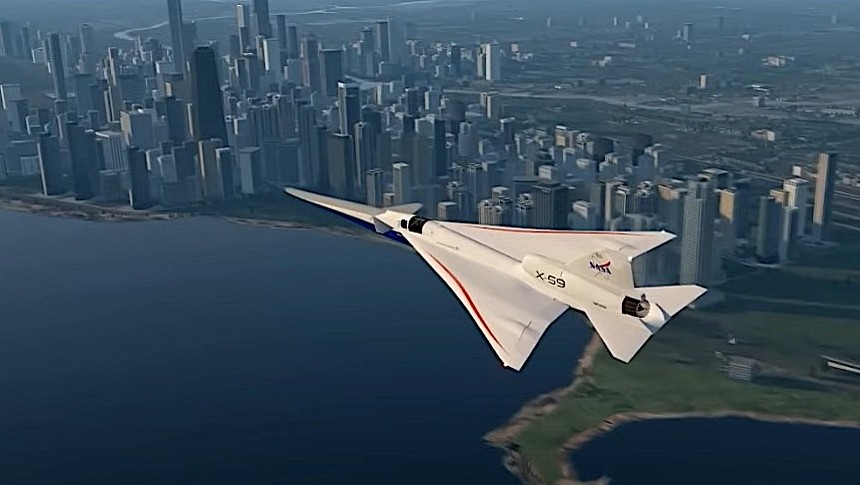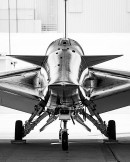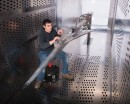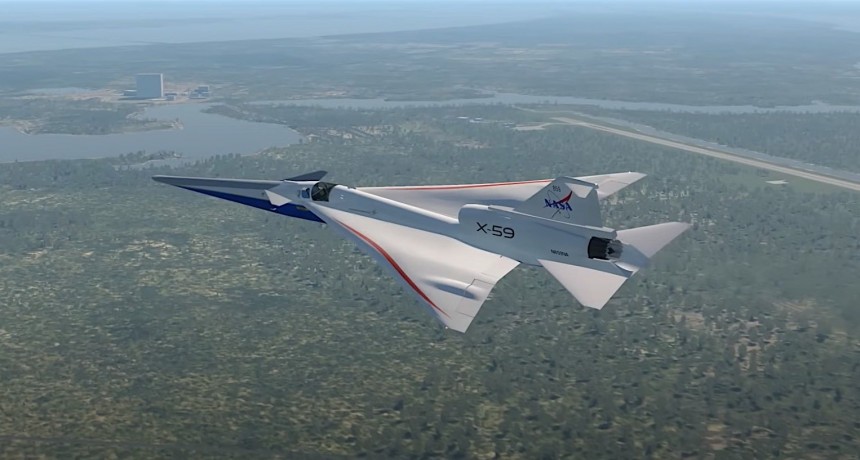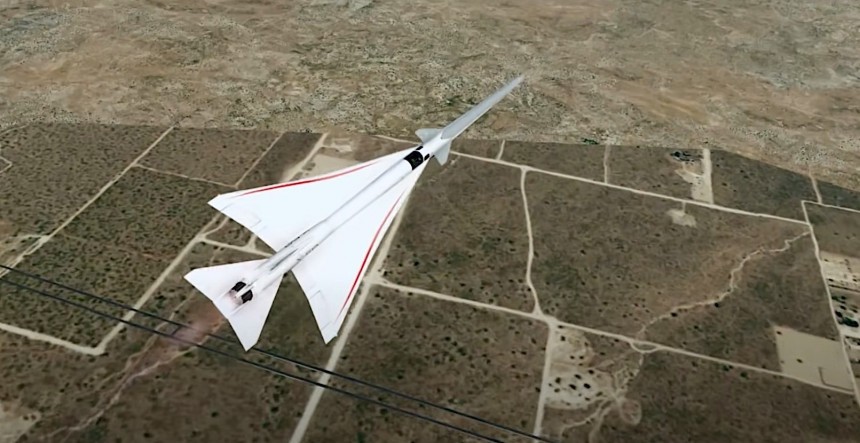Whereas on the space exploration front NASA had a pretty bad week – the Peregrine lunar mission failed, and the Artemis crewed missions to the Moon have been pushed back by a year – things are shaping up to be quite exciting for the agency's aviation efforts.
Tomorrow, January 12, NASA will pull the wraps off the X-59, an experimental aircraft that may very well change the shape of aviation in the decades to come. It's the culmination of almost six years of hard work, but also the start of a journey that may once again make civilian supersonic travel.
NASA calls the moment a "historic milestone in aviation history," and for good reason. If successful, it may put an end to a decade-old ban on the flight of certain kinds of aircraft over land.
About half a century ago (in 1973), at a time when supersonic aircraft were beginning to get a hold on military operations, but also on civilian travel, American regulators restricted the speed at which these machines could fly over populated areas to subsonic speeds. The reason for that? The noise they generated when traveling really fast (actually, when crossing the sound barrier) was too much to bear for the people on the ground.
Not even the Concorde, the world's first and only civilian supersonic aircraft, managed to work around that ban. The X-59 might change that, provided humans get a taste of supersonic travel once more.
The experimental plane's secret lies in its design. You see, in today's aircraft the sonic boom is generated because the hardware, as it moves through the air, creates a series of pressure waves in front of and behind it.
At such high speeds these pressure waves merge into one, and that in turn leads to a rise in pressure at the nose of the plane. Once the plane pushes through the wave, a sudden return to normal pressure follows.
This creates a sonic boom, which, when it comes to an F-16 flying at an altitude of over 8,000 meters (26,200 feet), for instance, translates into a massive 78 dB.
The weird shape of the X-59, which will be revealed in full on Friday, is meant to help with that. In a nutshell, the plane is shaped in such a way that it separates the shocks and expansions associated with supersonic flight.
This in turn should bring down the noise levels of the plane going supersonic to about 60 dB. If you don't know how much that is, NASA tells us it's about as loud as the volume of an average conversation with a friend. Or, if you want to think about it in some other way, the thing will be about as loud as the noise of a car door closing.
After the reveal at the end of the week, the aircraft will enter a series of ground tests, culminating at the end of the year with the first actual flight. Once that is out of the way, NASA plans to fly the plane over populated areas.
The goal of the plane and of the project it is part of (which is called Quiet SuperSonic Tecnology, or QueSST) is to determine exactly how loud such a design is in flight, but most importantly how loud is it perceived by the people on the ground.
Once it gathers all the relevant data, NASA will share it with American regulators, in a bid to make them rethink their policies.
The plane itself is not a prototype of some series-production aircraft, but data on how it was built and what makes it tick will be shared with the aviation industry in the hopes that, one day, someone will come up with a new aircraft that can move people at supersonic speeds.
NASA has major plans for the unveiling of January 12, and will broadcast the event, which will take place at the Lockheed Martin Skunk Works facility in Palmdale, California, on the agency's official streaming service, on the NASA app, YouTube, and on the agency's website.
A few days ago NASA invited all those interested in taking part, even as spectators, in this important moment in aviation history, to do so, and to share their plans with the world through a watch party map showing similar gatherings taking place all over the world.
Why, there is even an X-59 Watch Party Planning Guide you can consult to make sure you'll remember this moment forever. You can find it attached below the video, in the PDF section of this article.
We'll come back on the X-59 story tomorrow after the veil falls off the complete, fully-painted (in the colors of the American flag) aircraft. Until then, you can enjoy it a bit in digital form in the short video NASA released just hours before the official unveiling.
NASA calls the moment a "historic milestone in aviation history," and for good reason. If successful, it may put an end to a decade-old ban on the flight of certain kinds of aircraft over land.
About half a century ago (in 1973), at a time when supersonic aircraft were beginning to get a hold on military operations, but also on civilian travel, American regulators restricted the speed at which these machines could fly over populated areas to subsonic speeds. The reason for that? The noise they generated when traveling really fast (actually, when crossing the sound barrier) was too much to bear for the people on the ground.
Not even the Concorde, the world's first and only civilian supersonic aircraft, managed to work around that ban. The X-59 might change that, provided humans get a taste of supersonic travel once more.
The experimental plane's secret lies in its design. You see, in today's aircraft the sonic boom is generated because the hardware, as it moves through the air, creates a series of pressure waves in front of and behind it.
At such high speeds these pressure waves merge into one, and that in turn leads to a rise in pressure at the nose of the plane. Once the plane pushes through the wave, a sudden return to normal pressure follows.
The weird shape of the X-59, which will be revealed in full on Friday, is meant to help with that. In a nutshell, the plane is shaped in such a way that it separates the shocks and expansions associated with supersonic flight.
This in turn should bring down the noise levels of the plane going supersonic to about 60 dB. If you don't know how much that is, NASA tells us it's about as loud as the volume of an average conversation with a friend. Or, if you want to think about it in some other way, the thing will be about as loud as the noise of a car door closing.
After the reveal at the end of the week, the aircraft will enter a series of ground tests, culminating at the end of the year with the first actual flight. Once that is out of the way, NASA plans to fly the plane over populated areas.
The goal of the plane and of the project it is part of (which is called Quiet SuperSonic Tecnology, or QueSST) is to determine exactly how loud such a design is in flight, but most importantly how loud is it perceived by the people on the ground.
Once it gathers all the relevant data, NASA will share it with American regulators, in a bid to make them rethink their policies.
NASA has major plans for the unveiling of January 12, and will broadcast the event, which will take place at the Lockheed Martin Skunk Works facility in Palmdale, California, on the agency's official streaming service, on the NASA app, YouTube, and on the agency's website.
A few days ago NASA invited all those interested in taking part, even as spectators, in this important moment in aviation history, to do so, and to share their plans with the world through a watch party map showing similar gatherings taking place all over the world.
Why, there is even an X-59 Watch Party Planning Guide you can consult to make sure you'll remember this moment forever. You can find it attached below the video, in the PDF section of this article.
We'll come back on the X-59 story tomorrow after the veil falls off the complete, fully-painted (in the colors of the American flag) aircraft. Until then, you can enjoy it a bit in digital form in the short video NASA released just hours before the official unveiling.
